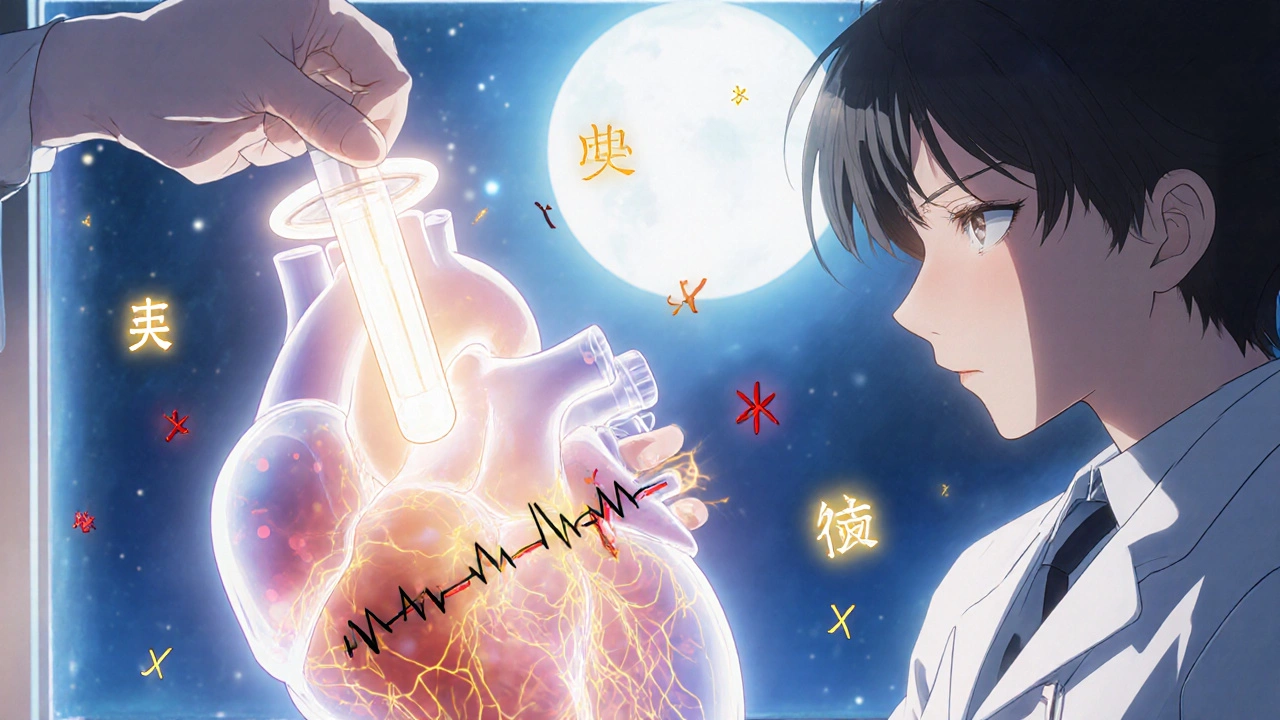Arrhythmia Treatment Decision Calculator
Find Your Best Arrhythmia Treatment Option
Answer these questions to get personalized recommendations based on your medical profile
If you’re taking Betapace (sotalol) for an irregular heartbeat, you’ve probably wondered: Is there a better option? Maybe you’re dealing with side effects like fatigue, dizziness, or worse-trouble breathing or a slow heart rate. Or maybe your doctor just told you to consider alternatives, and now you’re stuck wondering what else is out there. You’re not alone. Thousands of people with atrial fibrillation, ventricular tachycardia, or other arrhythmias face this same choice every year.
What Betapace (Sotalol) Actually Does
Betapace, the brand name for sotalol, is a dual-action drug. It’s both a beta-blocker and a Class III antiarrhythmic. That means it slows down your heart rate by blocking adrenaline (like metoprolol or atenolol), and it also lengthens the electrical recovery time in heart cells to prevent abnormal rhythms. It’s been used since the 1980s and is still prescribed for serious heart rhythm problems, especially when other drugs fail.
But it’s not simple. Sotalol has a narrow safety window. Too much can cause torsades de pointes-a dangerous, potentially fatal heart rhythm. That’s why doctors require hospital monitoring when starting it, and why regular ECGs are mandatory. It’s effective, yes-but it’s also high-risk.
Amiodarone: The Heavyweight Alternative
If Betapace doesn’t work-or if your arrhythmia is severe-your doctor might suggest amiodarone. It’s one of the most powerful antiarrhythmics available. Unlike sotalol, amiodarone works on multiple ion channels, making it effective for both atrial and ventricular arrhythmias. Studies show it’s more effective than sotalol at keeping people in normal rhythm long-term.
But here’s the catch: amiodarone has a long list of side effects. It can damage your lungs, liver, thyroid, and eyes. It stays in your body for months after you stop taking it. People on amiodarone need blood tests every 3-6 months and lung scans annually. It’s not a first-line choice unless your condition is life-threatening.
So if you’re young and otherwise healthy, amiodarone might be overkill. But if you’ve had a heart attack and keep getting dangerous rhythms, it’s often the best tool in the box.
Dronedarone: The Safer, But Weaker, Cousin
Dronedarone was created to be the safer version of amiodarone-with fewer side effects. It’s approved for paroxysmal or persistent atrial fibrillation in people who don’t have severe heart failure. It doesn’t accumulate in tissues like amiodarone, so the risk to your lungs and thyroid is much lower.
But it’s also less effective. In the ATHENA trial, dronedarone reduced hospitalizations for arrhythmias by 25%, but only about 40% of patients stayed in normal rhythm after one year. That’s worse than sotalol. And it’s not safe for people with advanced heart failure or permanent AFib.
If you’re looking for something gentler than Betapace but still want rhythm control, dronedarone is worth discussing. But if you need strong rhythm suppression, it might not cut it.

Flecainide and Propafenone: Fast-Acting for Paroxysmal AFib
For people with occasional, short bursts of atrial fibrillation-like those triggered by stress, caffeine, or alcohol-flecainide and propafenone are often preferred. These are Class Ic antiarrhythmics. They work fast to reset the heart’s rhythm and are commonly used in the “pill-in-the-pocket” approach.
You take one pill when you feel an episode starting. Many patients report feeling normal within an hour. It’s convenient, effective, and avoids daily medication.
But they’re dangerous if you have structural heart disease. If you’ve had a heart attack, have blocked arteries, or have reduced heart function, these drugs can increase your risk of sudden death. That’s why doctors always check your heart with an echocardiogram before prescribing them.
For the right person-healthy heart, infrequent episodes-this is a game-changer. For others, it’s a no-go.
Cardiac Ablation: Getting Rid of the Problem, Not Just Masking It
Medications treat symptoms. Ablation tries to fix the root cause. It’s a minimally invasive procedure where a catheter is threaded into your heart to burn or freeze the tiny areas causing the abnormal signals.
For paroxysmal atrial fibrillation, success rates are 70-80% after one procedure. For persistent AFib, it’s lower-around 50-60%-but still better than most drugs over time. Many people who’ve had ablation stop taking antiarrhythmics entirely.
It’s not risk-free. There’s a small chance of stroke, bleeding, or damage to the esophagus. But for active, younger patients who want to avoid lifelong pills, it’s often the best long-term solution.
And here’s the kicker: studies now show that early ablation (before trying multiple drugs) leads to better outcomes and fewer hospitalizations. If you’re under 65 and your arrhythmia is affecting your quality of life, ask about ablation before switching drugs.
Rate Control vs. Rhythm Control: The Bigger Picture
Not everyone needs to get their heart back to normal rhythm. Sometimes, just slowing it down is enough. That’s called rate control. Drugs like metoprolol, diltiazem, or digoxin can keep your heart rate under control without trying to fix the rhythm.
The EAST-AFNET 4 trial showed that early rhythm control (using drugs or ablation) reduces stroke and death in high-risk patients. But for older adults with no symptoms, rate control works just as well-and is much safer.
If your main issue is feeling your heart race, not the rhythm itself, you might not need Betapace or any antiarrhythmic at all. A simple beta-blocker could be enough.

When to Stick With Betapace
Despite its risks, sotalol still has a place. It’s often used when:
- You have ventricular tachycardia and need a drug that works reliably
- You’ve tried other drugs and they didn’t work
- Your kidney function is normal (sotalol is cleared by kidneys)
- You’re monitored closely with regular ECGs
It’s also cheaper than dronedarone or amiodarone. If you’re on a tight budget and your doctor has you under tight supervision, sotalol can be a practical option.
What to Ask Your Doctor
Don’t just accept a prescription. Ask these five questions:
- Is my arrhythmia life-threatening, or just annoying?
- Have I been checked for structural heart disease?
- What are the success rates and risks of each option for someone like me?
- Has ablation been considered as a first step?
- Can I try rate control instead of rhythm control?
Doctors don’t always bring up ablation or rate control because they’re trained to reach for pills first. But you have the right to know all your options.
Final Thoughts
Betapace isn’t the only answer-and for many people, it’s not the best one. Amiodarone is stronger but riskier. Dronedarone is safer but weaker. Flecainide is perfect for occasional episodes-if your heart is healthy. Ablation can free you from pills entirely. And sometimes, just slowing your heart rate is all you need.
The right choice depends on your age, heart health, how often you have episodes, and what you’re willing to tolerate. There’s no universal winner. But there is a right one-for you.
Is Betapace (sotalol) dangerous?
Yes, it carries risks, especially torsades de pointes, a life-threatening heart rhythm. That’s why it’s only started in a hospital with continuous monitoring. Your kidney function must be normal, and you need regular ECGs. But for many people under careful supervision, the benefits outweigh the risks.
Can I switch from Betapace to amiodarone?
It’s possible, but not simple. Amiodarone is much stronger and has more long-term side effects. Doctors usually only switch if sotalol failed to control your rhythm or if you have a more serious condition like ventricular tachycardia after a heart attack. You’ll need frequent blood tests and lung scans if you start amiodarone.
Is dronedarone better than Betapace?
It’s safer for your lungs and thyroid, but less effective at keeping your heart in rhythm. If you have mild atrial fibrillation and no heart failure, dronedarone might be a good alternative. But if you need strong rhythm control, Betapace often works better-though with more monitoring.
Can I take flecainide instead of Betapace?
Only if you have a structurally normal heart. Flecainide is great for occasional atrial fibrillation episodes and can be taken as needed. But if you’ve had a heart attack, blocked arteries, or heart failure, flecainide can be deadly. Always get an echocardiogram before starting it.
Should I consider ablation instead of drugs?
Yes-if you’re under 65, have symptoms that affect your daily life, and your heart structure is normal. Ablation has higher long-term success than drugs and can eliminate the need for daily medication. Many patients report better quality of life after the procedure. Talk to an electrophysiologist about whether you’re a candidate.








15 Comments
Victoria Arnett
November 1, 2025 AT 01:26Ive been on sotalol for 2 years and honestly its been a nightmare my heart still races and i feel like a zombie
Kristen Magnes
November 1, 2025 AT 18:41Youre not alone and its okay to feel that way. Have you talked to your cardiologist about rate control instead? Sometimes slowing the heart is enough and youll feel way better without the side effects.
Rachel M. Repass
November 1, 2025 AT 22:30Rate control vs rhythm control is such a critical but overlooked paradigm shift. Most docs default to rhythm control because its what theyre trained on but the EAST-AFNET 4 trial showed early rhythm control only benefits high-risk patients. For low-risk folks like me with occasional AFib? Metoprolol and mindfulness work better than any Class III antiarrhythmic. The real villain here is pharmaceutical inertia.
Sharon M Delgado
November 3, 2025 AT 05:23Yes, yes, yes-this is exactly what I’ve been trying to say for years! Why are we still treating arrhythmias like they’re all the same? There’s no one-size-fits-all in cardiac electrophysiology, and yet doctors treat patients like they’re filling out a multiple-choice scantron. I’ve seen so many people get amiodarone when they needed flecainide-or worse, sotalol when they needed ablation. It’s not just medical malpractice-it’s systemic negligence.
HALEY BERGSTROM-BORINS
November 3, 2025 AT 07:03Did you know the FDA approved sotalol after a 3-month trial with only 87 patients? 🤔 And now millions are on it? Big Pharma doesn’t want you to know that ablation is cheaper long-term and doesn’t require lifelong blood tests… or that amiodarone was originally developed as a thyroid drug… 💊👁️🗨️ #PharmaSecrets
Arthur Coles
November 4, 2025 AT 23:42They’re all poison. Sotalol? Toxic. Amiodarone? Worse. Dronedarone? A placebo with a fancy label. Ablation? They’ll cut you open and call it ‘minimally invasive’ while billing you $50K. And don’t get me started on how they hide the fact that 60% of AFib cases resolve on their own if you just stop caffeine and stress. They don’t want you cured-they want you subscribed.
Carlo Sprouse
November 5, 2025 AT 14:45While the preceding commentary contains several valid clinical observations, it is critically deficient in its failure to contextualize the pharmacokinetic and pharmacodynamic profiles of Class Ic versus Class III agents within the framework of the HRS/EHRA/ECAS 2023 guidelines. Sotalol remains a second-line agent for ventricular arrhythmias only in the absence of structural heart disease, whereas flecainide is contraindicated in patients with ejection fraction <40% regardless of symptom burden. The notion that ablation should be a first-line intervention is not supported by current meta-analyses unless the patient is under 55, paroxysmal, and refractory to at least two antiarrhythmics.
Cameron Daffin
November 7, 2025 AT 00:45I get that everyone’s got strong opinions here, and honestly? That’s good. But let’s not turn this into a war of meds vs. procedures. I was on sotalol for a year, had a bad reaction, switched to dronedarone, felt worse, then tried ablation-and it changed my life. I’m off all meds now. No conspiracy, no pharma agenda-just my heart finally working right. The point isn’t which drug is ‘best’-it’s finding what works for YOU. And if your doctor won’t talk ablation? Find one who will.
Donna Hinkson
November 7, 2025 AT 14:59Thank you for writing this. I’ve been terrified to ask my doctor about ablation-I thought I was too old (68) and that I should just ‘live with it.’ But now I’m going to ask. I deserve to feel normal again.
Steve Dressler
November 8, 2025 AT 19:07There’s a quiet revolution happening in cardiology: rhythm control isn’t always the goal. For older patients with comorbidities, rate control with beta-blockers or calcium channel blockers reduces hospitalizations and improves quality of life more than aggressive rhythm interventions. The obsession with ‘normal sinus rhythm’ is rooted in 1990s thinking. We’ve learned that the heart doesn’t need to beat like a metronome to be healthy. Sometimes, a steady 70 is better than a chaotic 60.
Wendy Tharp
November 9, 2025 AT 14:06Of course they don’t tell you about the real alternative: magnesium. Low magnesium is the #1 cause of arrhythmias and nobody tests for it. You think Big Pharma wants you taking a $5 supplement instead of a $300 pill? Pfft. They’d rather you die slowly on sotalol than admit the truth.
Cori Azbill
November 10, 2025 AT 17:21Why are we even talking about American drugs? In Europe they use vernakalant and propafenone as first-line. And in Japan? They use Japanese herbal formulas that don’t wreck your liver. We’re so behind because the FDA is a puppet of Big Pharma. Why are we still using 1980s meds? It’s embarrassing.
Sharron Heath
November 11, 2025 AT 23:34As someone who works in cardiac telemetry, I see patients on sotalol every day. The monitoring protocol is non-negotiable. One patient had torsades because her creatinine clearance wasn’t checked after a bout of dehydration. She didn’t die-but she spent three weeks in the ICU. Please, if you’re on this drug: hydrate, get your labs, and don’t skip your ECGs. It’s not paranoia-it’s survival.
Subham Das
November 13, 2025 AT 09:32The entire paradigm of pharmaceutical intervention in cardiac arrhythmia is a metaphysical failure. We treat symptoms as if they are the disease, when in fact, the arrhythmia is merely the shadow cast by systemic inflammation, autonomic dysregulation, and the existential alienation of modern life. To prescribe sotalol is to ignore the soul’s rhythm. The body remembers trauma. The heart remembers fear. No pill can restore what the soul has lost.
Tom Hansen
November 14, 2025 AT 20:53ablation is just a scam. i had it done. 6 months later i was back on sotalol. they just cut your heart and charge you 50k. doctors are all in it for the money